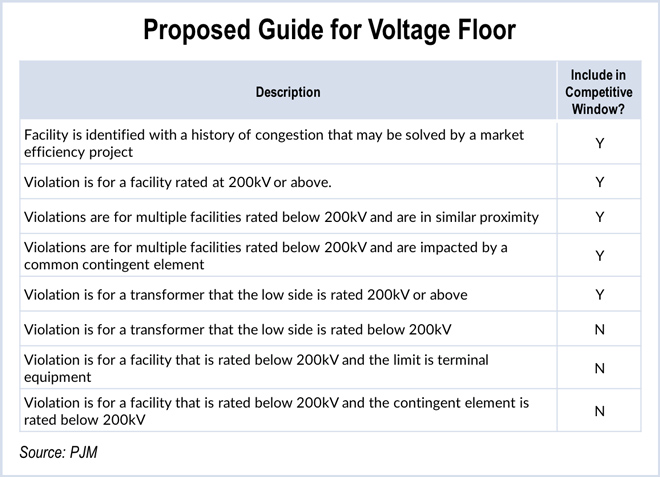Competitive developers expressed reservations last week about a PJM proposal to exclude transmission projects below 200 kV from competition.
PJM said projects below 200 kV are almost always allocated to one zone and thus automatically assigned to the incumbent transmission owner.
PJM’s Suzanne Glatz said the “voltage floor” would allow the RTO to eliminate the cost of evaluating competitive proposals in cases where the likely solution is a transmission owner upgrade. The voltage threshold would not apply to market efficiency projects.
Of 1,523 projects approved by the PJM Board of Managers under the Regional Transmission Expansion Plan, 104 (7%) were greenfield projects, of which only 13 (less than 1%) were allocated to more than one zone and thus open to competition, Glatz said.
In 2014, only two of 55 projects selected to correct violations below 200 kV resulted in solutions above 200 kV. Both projects were transmission owner upgrades.
“There’s very few that are coming out as potential greenfield [competitive] projects,” Glatz said.
“Is 15 years really a sufficient baseline for what the future may hold?” asked Sharon Segner of LS Power, citing technology changes affecting demand response and energy efficiency. Segner also questioned why PJM’s analysis failed to include 2015 submissions, which included dozens of lower voltage submissions from the marketplace.
Brenda Prokop of ITC Holdings said her company doesn’t favor a voltage floor but that PJM’s criteria for excluding projects (see table) “gives us a little more comfort.”
“We appreciate PJM’s effort to balance interests” of developers and efficiency, she said.
Vice President of Planning Steve Herling said PJM would like to implement the changes in 2016.
Climate Change Impact? Higher Highs has PJM Adjusting Weather Forecasts
PJM is planning to change the way it forecasts weather in its planning studies due to a trend of higher peak temperatures.
The RTO has based its forecasts on temperature and humidity data from 26 weather stations dating back to 1973. But a new analysis revealed that peak readings for 1993-2013 were higher than those for 1973-1993.
Twenty of 26 weather stations had higher maximum temperature humidity index readings in the last 20 years than the earlier period, PJM’s Andrew Gledhill said.
As a result, Gledhill said, the RTO plans to exclude the earlier data and rely on that from 1994/95. It will reevaluate the historical base on a regular schedule — perhaps every five years — going forward.
Gledhill said a survey of North American forecasters indicated that most use samples of 20 years or less. “The fact that PJM uses 40 years — we’re kind of an outlier,” he said.
The change would suggest higher load forecasts, countering factors such as lackluster economic growth and energy efficiency that are likely to mute projected load growth. Herling said PJM will offer stakeholders a look at the combined impact of all of the load forecast changes at the Planning Committee’s September meeting.
Exelon’s Rebecca Stadelmeyer and FirstEnergy’s Jim Benchek asked for more discussion of the weather forecasting at the Load Analysis Subcommittee.
“This is a drastic change to what we’re used to,” Stadelmeyer said. “We want to be comfortable [with the change]. We’re not now.”
“We’re very uncomfortable at this time,” Benchek said.
— Rich Heidorn Jr.



